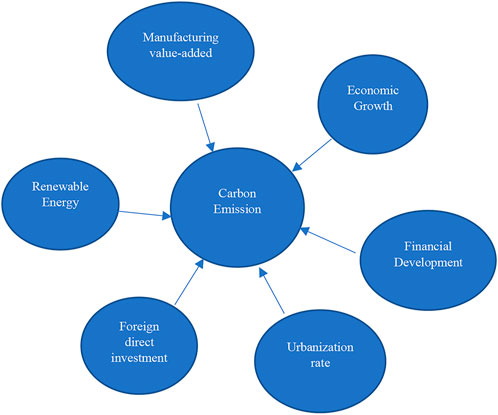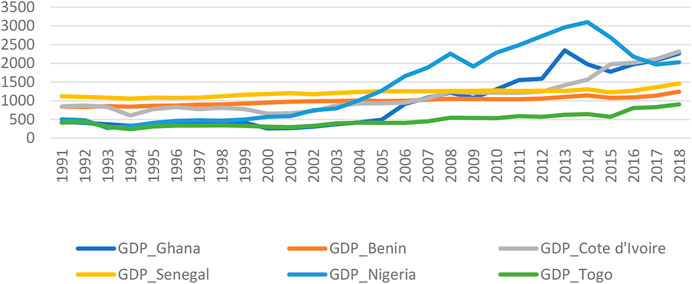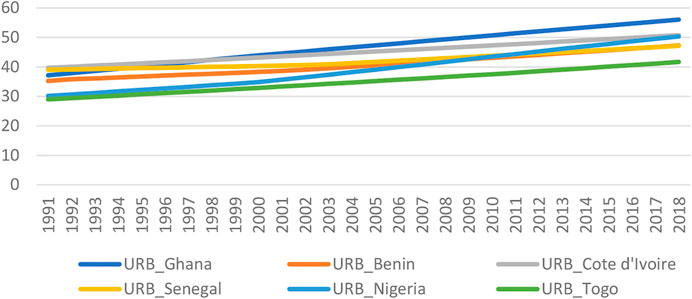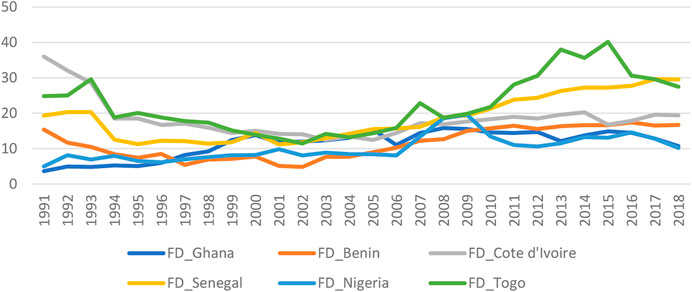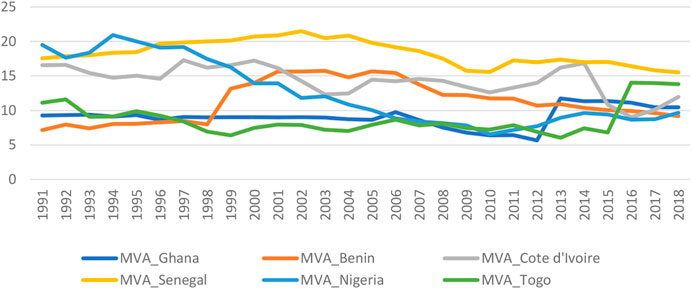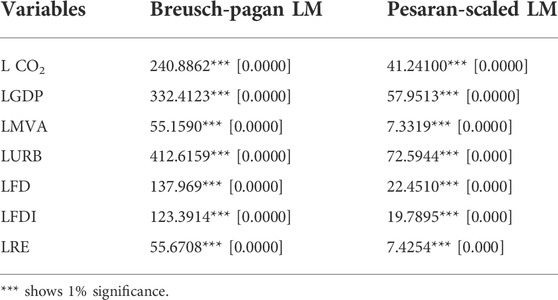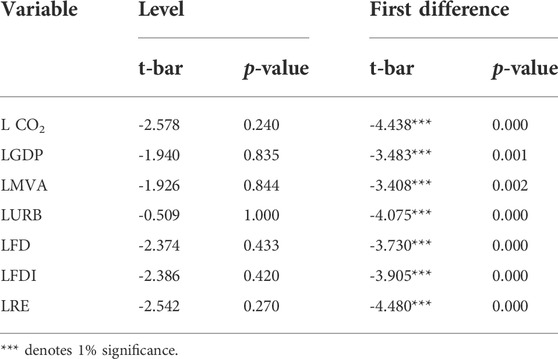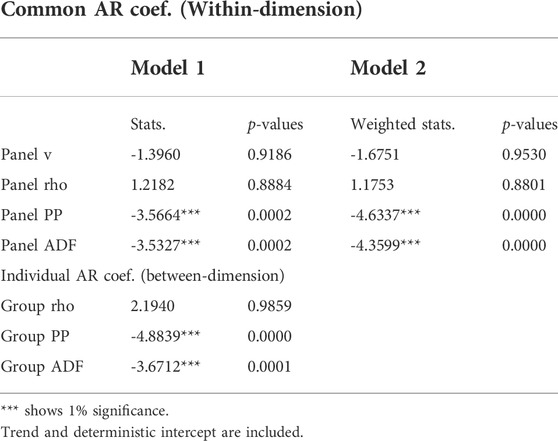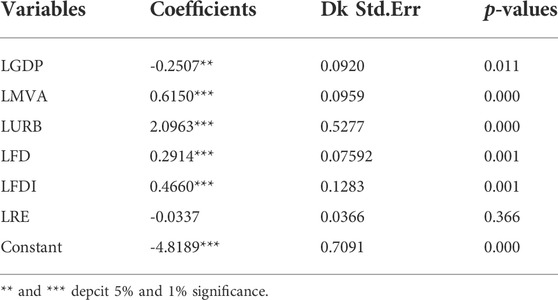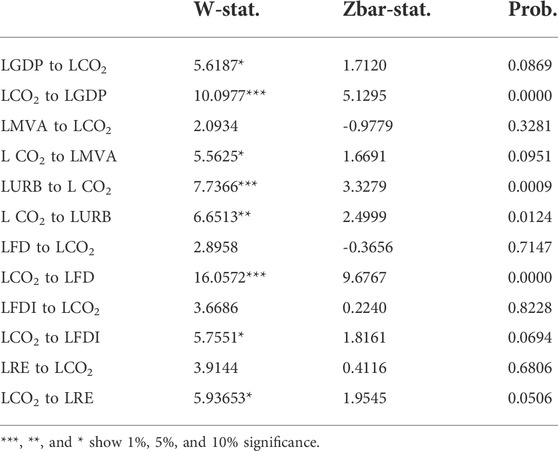- 1Mohammed VI Polytechnic University, UM6P, School of Architecture Planning and Design SAP+D, Ben Guerir, Morocco
- 2Ecole Polytechnique Fédérale de Lausanne, EPFL, Lausanne, Suisse
- 3Department of Accounting and Finance, Faculty of Economics and Administrative Sciences, Cyprus International University, Nicosia, Turkey
- 4Department of Business Administration, Faculty of Management Sciences, ILMA University, Karachi, Pakistan
The countries in Western Africa have the greatest potential for renewable energy generation in the world and are likely to be vulnerable to the adverse effects of climate change. Unfortunately, only a few of them have tapped into this potential, as non-renewable energy still dominates the total energy mix of these countries. The present study explores the effect of economic growth, manufacturing value-added, urbanization, financial development, foreign direct investment, and renewable energy consumption on the environmental quality in West African countries by using a sample of some selected countries over the period 1991–2018. This study is analyzed by adopting the method of Driscoll-Kraay (DK) panel regression. The panel result suggests that manufacturing value-added, urbanization, financial development, and foreign direct investment increase environmental degradation. In addition, the findings of this study reveal that economic growth and renewable energy consumption contribute, significantly, to environmental quality. Bidirectional causality exists between economic growth and CO2 emissions and between urbanization and environmental degradation. Accordingly, in order to improve environmental quality in these countries, it is imperative to embrace and promote the consumption of clean energy sources, which will contribute more to the promotion and adoption of renewables in this strategic region.
1 Introduction
Rapid urbanization, rising energy consumption in the manufacturing sector, and high economic growth are all contributing factors to the world’s environment being degraded as a result of rising global warming and climatic changes. The worldwide community and several research institutions have attempted to explain the environmental effects of urbanization, manufacturing activities, the use of renewable energy sources, as well as economic expansion in the region of Western Africa, as a solution to this challenge. The ecological modernization theory contends that when countries move from low to intermediate stages of development and prioritize economic expansion over a sustainable environment, environmental concerns may worsen. However, as countries prioritize environmental sustainability, the society becomes modernized leading to increased innovation in the manufacturing sector and a transition toward a service-based economy. Thus, environmental deterioration alleviates, and environmental sustainability increases.
The urban environmental transition theory, on the other hand, contends that when civilizations move to manufacturing-based economies, air pollution rises along with urban prosperity. With better environmental legislation, financial advancement, and economic structural change, pollution declines as cities get affluent. Furthermore, the demand for urban infrastructure and energy-intensive goods is anticipated to rise in affluent cities, adding to the environmental burden. The compact city theory, on the other hand, emphasizes the advantages of urbanization by making the case that greater urban density enables public infrastructure to experience economies of scale, which reduces environmental strain and harm. However, increased urban density without sufficient urban infrastructure might result in environmental harm. These theoretical claims imply that urbanization does indeed have variable environmental impacts (both positive and negative) at various phases of development, with the overall impact being difficult to estimate. As a result, over the past 10 years, empirical research on the relationship between urbanization and the environment has been conducted.
In recent studies, non- and semi-parametric regression has been used as a more adaptable estimating framework to avoid any functional form’s misspecification bias in finding the true shape of the urbanization-pollution link (Zhu et al., 2012; Xu and Lin, 2015). For 20 emerging countries, Zhu et al. (2012) found scant evidence to support the inverted U-shaped link. For the OECD countries and China, respectively, Xu and Lin (2015) discover an inverted U-shaped link between urbanization and CO2 emissions. In conclusion, the evidence that is currently available on the relationship between urbanization and the environment is contradictory and ambiguous because the direction and nature of the association rely on the nations chosen, the data sample, and the estimating method. Studies on the relationship between urbanization and pollution in Africa are still in their infancy. According to Onoja et al. (2014), urbanization has a small but positive impact on CO2 emissions. Using dynamic heterogeneous panel data models, Adusah-Poku (2016) discovers that urbanization in Sub-Saharan Africa has a beneficial long-term and short-term impact on CO2 emissions.
Based on this background, this study complements the literature in several ways. Firstly, this study investigates the impact of urbanization and economic growth on the environmental quality in six West African countries. Secondly, this study integrates the manufacturing value-added, renewable energy use, financial development, and investment into one framework to probe their impact on African environmental degradation. No existing research has combined all these indicators together for environmental policies; thus, this study makes a unique contribution under the specific background of Western Africa. Lastly, in order to further investigate the possibility of a clear urbanization-environment relationship in the presence of other indicators, this paper uses data from a sample of six West African countries for the period 1991–2018. The research is carried out utilizing the Stochastic Impacts by Regression on Population, Affluence, and Technology (STIRPAT) model, which has emerged as the standard analytical framework for assessing the mechanisms driving anthropogenic environmental change. Additionally, the article makes use of Driscoll-Kraay’s (DK) panel regression to evaluate the previously unidentified urbanization-environment link in West Africa.
2 Literature review
In order to preserve stable growth or development, emerging nations have strayed from the path toward becoming low-carbon civilizations (Ali et al., 2019b). There is a close link between growth, environmental quality, and energy. According to Temiz Dinç and Akdoğan (2019), effective management of these factors is essential for human wellbeing, sustainable development, and workable policy direction. Because of this, there are numerous studies that have looked at the connections between the aforementioned factors and the potential impact of renewable energy (RE) on environmental sustainability. Saidi et al. (2018) investigated the relationship between institutional quality, RE, and economic growth in MENA nations. Abdouli and Hammami (2017) examined the relationship between non-RE and economic growth in 17 MENA nations from 1990 to 2012 and came to a similar conclusion.
According to certain studies, urbanization has a beneficial impact on CO2 emissions (Parikh and Shukla, 1995; Cole and Neumayer, 2004; Liddle and Lung, 2010; Poumanyvong and Kaneko, 2010; Ahmed et al. 2019). In this context, York et al. (2003) discover that urbanization has a beneficial impact on emissions using the STIRPAT model. For 86 nations between 1975 and 1998, Cole and Neumayer (2004) discover a positive correlation between urbanization and CO2 emissions. According to Poumanyvong and Kaneko (2010), there is a positive correlation between urbanization and CO2 emissions for all income groups (low-, middle-, and high-income countries), with the middle-income group showing the strongest correlation.
Additionally, there are research works that contradict the ones described above (please see, Fan et al., 2006; Sharma, 2011; Sadorsky, 2014). According to Fan et al. (2006), urbanization and CO2 emissions in developing nations are negatively correlated. Sharma (2011) suggests that urbanization and CO2 emissions are negatively correlated in high-, middle-, and low-income nations. Sadorsky (2014) examines the relationship between urbanization and CO2 emissions in developing nations and discovers that, depending on the estimating method, the effect of urbanization is typically positive but statistically inconsequential. Although the majority of studies point to a linear relationship between urbanization and pollution, a non-linear relationship has also been considered by academics due to a lack of conclusive data.
According to research, increasing energy usage can boost economic growth. Using the panel VAR approach, Charfeddine and Kahia et al. (2019) examined the impact of RE use on CO2 emissions in the MENA region from 1980 to 2015. The results indicated that RE had a negligible impact on CO2 emissions. Gorus and Aslan (2019) evaluated the factors that contributed to environmental degradation in MENA from 1980 to 2013 in the same region. It was found that non-RE contributes to the deterioration of the ecosystem. Jin and Kim (2018) looked into the factors that affected CO2 emissions in 30 nations between 1990 and 2014. The study found that, in contrast to RE, nuclear energy increases CO2 emissions. Therefore, the creation of RE is crucial to stopping global warming. In five MERCOSUR countries, De Souza et al. (2018) investigated the effects of RE, non-RE consumption, and income on the environment. Results demonstrated the significance of RE in reducing CO2 emissions. Kahia et al. (2019) found a comparable outcome for the MENA.
From 1980 to 2012, Hassine and Harrathi (2017) investigated the relationship between RE use, trade, and economic growth in the GCC countries. They came to the conclusion that financial development, exports, and RE can genuinely spark economic growth. Sinha et al. (2017) looked into the relationship between energy and the environment in the N-11 nations. The GMM approach provided evidence that RE slows economic growth while non-RE has the reverse effect. Given that the N-11 nations rely on non-RE sources, they explained their findings by pointing out the expense of putting RE systems in place. Rasoulinezhad and Saboori (2018) offered evidence from both the FMOLS and DOLS results that RE reduces CO2 emissions, in line with other comparable studies, but for the case of 12 chosen Commonwealth States. The same influence on CO2 emissions was also exerted by financial development. In addition, several studies (such as Shahbaz et al., 2012; Shahbaz et al., 2013; Boutabba, 2014; Katircioğlu and Taşpinar, 2017; Ahmed et al., 2021a; Ahmed et al. 2021b) support the idea that CO2 emissions and financial development are inversely related, whereas other studies found a positive correlation (Pao et al., 2011; Pao and Tsai, 2011; Al-Mulali et al., 2015; Farhani and Ozturk, 2015). Zafar et al. (2019) disaggregated energy into two main sources and estimated how each source affects growth in Asia-Pacific nations. The Continuously Updated FMOLS approach revealed that RE, R&D, and commerce contribute to growth, while non-RE sources did not influence growth.
In a study comparable to that of Zafar et al. (2019), Nathaniel and Iheonu (2019) excluded the R&D variable for the instance of Africa. They discovered that RE does not make much of a difference in reducing CO2 in Africa. Riti and Shu (2016) investigated the connections between RE and energy efficiency for an eco-friendly atmosphere in a single country scenario. Results confirmed that RE improves the quality of the environment in Nigeria. Khoshnevis Yazdi and Ghorchi Beygi (2018) previously looked into how RE affects CO2 emissions in Africa. Findings imply that lowering CO2 emissions, commerce, and RE enhances environmental quality. Ali et al. (2019a) evaluated the awareness of different urban neighborhoods in Xiamen about RE and energy saving. They found a strong link between household size, income, and energy consumption. For the Bangkok metropolitan area, Ali et al. (2018) looked at the valuation and validation of carbon sources. They discovered that the urban region occupies more than 60% of the metropolitan area.
Around the world, manufacturing enterprises are a major cause of water pollution. The ecosystem was harmed by the illegal release of hazardous gases, tainted water, heavy metals, chemicals, and radioactive elements into streams. However, there is a dearth of literature that examines how the manufacturing sector affects the environment, particularly in Africa. To reduce manufacturing-related emissions, advanced manufacturing enterprises must prioritize sustainable manufacturing (Khan et al., 2021b). According to Harun et al. (2013), the environmental impact of manufacturing is influenced by the product’s design and the use of materials. Additionally, the manufacturing industry has used a tremendous amount of energy and resources, which has had a significant impact on economic growth. It is abundantly obvious that increased production in an economy and economic growth depend on a thriving manufacturing sector. The term “technology effect of globalization” refers to the new technological concepts and manufacturing processes that are taken into consideration when economic expansion stabilizes along with the scale effect. Because of investments and commerce that don’t contribute to pollution, this effect lowers CO2 emissions.
Another factor to examine in relation to carbon emissions is financial development. In any civilization, financial development has a significant impact on CO2 emissions. For instance, Sadorsky (2011) investigated how monetary enhancements cover the customer’s approach to the items’ consistency and strength, which boosted energy use and environmental emissions. The business community has the chance to increase money to increase production operations thanks to financial development. According to Charfeddine and Khediri (2016), financial development cannot be accurately measured without taking into account the effects of manufacturing value-added growth and domestic lending to the private sector, which is scaled by real GDP as a proxy for measuring financial development.
The growing interest in the urbanization dynamics on the African continent has led to emerging studies exploring the nexus between environmental quality, urbanization, and economic growth. Despite being scanty, some studies have concentrated on a single country (Ali et al., 2016) or a panel of countries on the continent with others elsewhere (Poumanyvong and Kaneko, 2010; Martínez-Zarzoso and Maruotti, 2011; Al-mulali et al., 2012) but not a panel of West African countries altogether. This paper seeks therefore to fill this gap by investigating the relationship between the increasing urbanization, economic dynamics, renewable energy consumption, manufacturing value-added, financial development, investment, and CO2 emissions concentrating on the West African urban cluster.
3 Material and methods
We utilized selected variables namely CO2 emissions (CO2), economic growth (GDP), manufacturing value-added (MVA), urbanization (URB), financial development (FD), foreign direct investment inflows (FDI), and renewable energy use (RE). In this research study, we included six West African countries including Benin, Ghana, Senegal, Cote d’Ivoire, Togo, and Nigeria. The United Nations defines Western Africa as 16 countries but we choose only these six West African countries because they are the most urbanized and developed in terms of economic growth in this strategic region. We used annual data from 1991 to 2018. Though we intend to use longer and updated data, consistent balanced data on CO2 emissions were only available up to 2018.
The data have been taken from the World Development Indicators (WDI) (2020), while data on renewable energy have been collected from International Energy Agency (IEA) website. This study will pursue the following function to estimate carbon emissions.
In Eq. 1, CO2 refers to carbon emissions measured in metric tons. GDP is per capita gross domestic product, current US dollars, used as a proxy of economic growth, MVA is Manufacturing value-added (% of total GDP), URB is urbanization rate in percentage of the total population, and FD refers to financial development, which is the % of GDP and is extended through the proxy “domestic credit issued to the Private sector”. In addition, FDI is the foreign direct investment inflows measured in percentage of GDP (see Table 1 and Figure 1). All the variables in this model are transformed into logarithm form to avoid sharpness in the data.
In Eq. 2, i represents the number of countries, t shows the quantity of time, and ε is the error term. Further,
4 Results and discussion
It is imperative to check the descriptive statistics of the panel data before examining the data series in order to observe the variability and distribution of the variables. Table 2 summarizes the sampled data set for the 6 West African countries over the 27-years time frame (1991–2018) of the variables. It is evident that on average, CO2 emissions, gross domestic product, manufacturing value-added, urbanization rate, financial development, foreign direct investment, and renewable energy use in the selected West African countries are 0.33, $1005.7, 12.37, 41.54%, 15.39,19.75, and 0.023%, respectively. The documented findings show that the maximum of 0.68 CO2 emissions is recorded in Benin and a minimum of 0.06 is recorded in Nigeria (Figure 2) with an average annual rate of 0.337. GDP ranges from $ 238.5 to $3099.0 with a sample mean value of $1005.7 (Figure 3). Furthermore, for urbanization, it can be seen that a maximum of 56.06% urbanization rate is observed in Ghana and a minimum of 29.00% is observed in Togo (Figure 4) with an average annual rate of 41.54% for the whole sample. For financial development, it can be seen that a maximum of 40.16 is recorded in Togo and a minimum of 3.65 is recorded in Ghana (Figure 5) with an average annual rate of 15.39 for the panel. For the case of manufacturing value-added, it can be observed that the sampled economies recorded a maximum of 21.49 in Senegal and a minimum of 5.66 in Ghana (Figure 6) with an average of 12.37 for the panel. Concerning renewable energy use, the maximum is 0.083 and the minimum is 0.00045 with an average annual rate of 0.023.
West African countries are connected to each other due to manufacturing activities and other economic-related sectors. These associations may lead to cross-sectional reliance among the countries. Therefore, as a first step, we tested for cross-sectional dependence or independence in the panel. It is very important to check the cross-sectional dependence (CD) issue before estimating the panel data of Western Africa to produce rigorous results. In this regard, Breusch-Pagan’s LM test and Pesran’s Scaled LM test are used in Table 3. Both of them are applied for assessing CD and their findings evidenced CD in data.
In the second step, unlike the conventional unit root tests, the second-generation test (i.e., CADF test) is applied for unit root testing. This is critical to apply this method of Pesaran (2007) since it can reveal the integration level amidst CD and heterogeneity. The empirical results shown in Table 4 assured that variables in the Western Africa panel are integrated at 1 (1), so we can check the cointegration among variables.
After establishing the integration order of the selected series, we proceed to study the cointegration features by using the Pedroni test and the Westerlund (2008) test in the third step of our empirical study. The results of the Pedroni test depicted in Table 5 indicate cointegration because the majority of statistics are significant. Furthermore, the results of the Westerlund test illustrated in Table 6 disclosed that there is evidence of the long-run association between CO2 as the dependent variable and our selected explanatory variables, which suggests evidence of cointegration among the series. Thus, we accept the alternative hypothesis and reject the null hypothesis of “no cointegration”.

TABLE 6. Cointegration test Westerlund (2008).
After finding cointegration among variables, we use the Driscoll-Kraay (DK) panel regression introduced by Driscoll and Kraay (1998). The advantages of this method are appropriate for this panel study, for example, it generates consistent and effective findings in the presence of CD and the standard errors generated by this technique are reliable (Sarkodie and Strezov, 2019). DK regression can provide the missing values and therefore, is considered more suitable for unbalanced and balanced panels. This method also handles the problem of serial dependency and heteroscedasticity in panel datasets (Rasheed et al., 2022).
The empirical results of our selected West African counties panel are presented in Table 7 by using the Driscoll-Kraay Regression for understanding the impacts of the economic growth, manufacturing value-added, population growth, financial development, foreign direct investment inflows, and renewable energy consumption on CO2 emissions. The findings show that GDP has a negative impact on CO2 emissions, indicating that the economic growth in West Africa plays an important role in improving environmental quality i.e., a 1% increase in GDP would increase environmental quality by 0.25%. These empirical results agree with the outcomes of Shahid et al. (2022) for BRICS (excluding South Africa) from 1997 to 2020, Odugbesan and Adebayo (2020) for Nigeria, Solarin et al. (2018) for developing and developed nations, Kirikkaleli and Adebayo et al. (2021) for the global panel, Awosusi et al. (2022) for Columbia, Ahmad et al. (2022) for emerging countries, and Xin et al. (2021) for the United States. This result is plausible because the increase in growth expands research and development, innovation, advanced technologies, environmental preferences, and environmental regulations, which mitigate environmental pollution (Ahmed and Wang, 2019).
The coefficient of MVA is positive and statistically significant, this suggests that in the long run, a 1% increase in MVA in the selected African countries would lead to a 0.615% increase in CO2 emissions when other variables are held constant. In other words, this positive effect of LMVA on environmental degradation indicates that MVA contributes positively to CO2 emissions of the selected African countries in the long run and this is very normal because manufacturing industries are contributing to pollution across the globe. These empirical results go in line with the paper of Khan et al. (2021a) for the United States and Khan et al. (2021b) for thirty-eight IEA countries. This study also proves that URB affects CO2 emissions positively and reports that a 1% increase in URB would decrease environmental quality by 2.096% in the long-run. URB is positively linked with CO2 which implies that rapid urbanization upsurges CO2. This result opposes the view that high urbanization is crucial to promoting environmental sustainability (Ahmad et al., 2021). However, this estimate goes in line with many studies that describe detrimental environmental effects of urbanization, for example, Ahmed et al. (2020a) in China, Ahmed et al. (2020b) in G7.
FD has a positive and significant impact on CO2 emissions in the long run for the selected African countries when other variables are held constants. These results show that a 1% increase in FD would decrease environmental quality by 0.291% in the long-run, when other variables are held constants, conversely to the results shown in the paper of Rafique et al. (2020) for BRICS. For foreign direct investment, the coefficient is also positive and statistically significant suggesting that FDI increases CO2 emissions in the long run, a 1% increase in LFDI leads to a 0.466% increase in CO2 emissions. In contrast, this study also concludes that the RE-CO2 interrelationship is negative, illustrating that a 1% increase in RE triggers CO2 emissions by 0.034% when other variables are held constants. This indicates that, at a high pollution level, an improvement in renewable energy use has a significant positive impact on the quality of the environment. This implies that renewable energy utilization plays a vital role in mitigating the emissions level in West Africa Region. These empirical results agree with the outcomes of Orhan et al. (2021) for India, Kirikkaleli and Adebayo (2021) for India, Shan et al. (2021) for highly decentralized economies, and Kirikkaleli and Adebayo (2020) for the global context. In general, using renewable energy may become a crucial instrument in reducing CO2 emissions as it lowers carbon footprint and produces negligible CO2. For example, solar energy produces only 0.2 pounds of CO2 energy per kilowatt-hour (CO2E/kWh) compared to the burning of natural gas (2 pounds of CO2E/kWh) or coal (3.6 pounds of CO2E/kWh). In addition, renewable energy deployment may reduce the energy intensity of GDP and create more jobs in non-carbon intense industries in the continent.
The causality method of Dumitrescu and Hurlin (2012) is also adopted for estimating the flow of causality between CO2 and each regressor. This test is also appropriate during cross-sectional dependence and heterogeneity. As can be seen in Table 8, there is evidence of a bidirectional linkage between GDP and CO2 and also between Urbanization and CO2 which indicates that an improvement in GDP development and the rate of urbanization can impact environmental quality in West Africa. The feedback effects exist between carbon emission and manufacturing value-added. Further, unidirectional causality runs from carbon emissions to financial development, carbon emissions to FDI, and carbon emissions to renewable energy use.
5 Conclusion and policy implications
5.1 Conclusion
The study has examined the relationship between CO2 emissions, economic growth, manufacturing value-added, urbanization, financial development, FDI, and renewable energy consumption for a sample of six West African countries. The study demonstrates that the manufacturing value-added, urbanization, financial development, and FDI contribute significantly to the increase of CO2 in Western Africa. On the other hand, economic growth and renewable energy consumption reduce the environmental degradation in this region. The empirical results also indicate that in these selected African countries, there is a bidirectional relationship between economic growth and CO2 emissions. Further analysis shows that a bidirectional causal relationship exists between urbanization and CO2 emissions.
5.2 Policy implication
Our results offer several policy implications to reduce environmental pollution in the Western Africa region. To ensure sustainable urbanization and energy consumption in Western Africa, there is a need to put in place an urban development policy that will accommodate the rate of urbanization, and an energy policy that will ensure the sustainability of the energy consumption in the long-run. Furthermore, there is a need for the West African countries to transform their industries into a green economy, which is the best way to combat the environmental challenges emanating from economic growth. In the manufacturing process, sustainability refers to the creation of products that are produced in an economically sensible way. These products are created in an environmentally conscious way, as well as in the most efficient manner. This method of production supports the safety of employees, communities, and products. Thus, the focus should be on innovation-driven sustainable industrialization. The countries in West Africa should enforce their rules and regulations regarding the conservation of the environment so that environmental health is more emphasized. Finally, to achieve urbanization sustainability in West African countries, effective energy, economic, and environmental policies are required to guide the rate of urbanization development in those countries without compromising economic growth and to ensure a decrease in CO2 emissions to achieve better environmental quality. The policymakers in urban planning in West Africa should aim at reducing the urbanization level by practicing effective land use to encourage green and intelligent urbanization, which will to some extent ameliorate the influence of urbanization on environmental degradation.
Despite the study’s considerable contribution to environmental literature, particularly in Western Africa, it has several drawbacks. These drawbacks stem from the study’s utilization of only six parameters. Future research may incorporate more parameters and investigate their impact on various environmental metrics. Also, upcoming research should scrutinize this connection in the framework of the Environmental Kuznets curve. Given the unavailable datasets, it would be desirable to address these constraints in future studies.
Data availability statement
The raw data supporting the conclusions of this article will be made available by the authors, without undue reservation.
Author contributions
HR: supervision, project administration, writing—review, and editing. SB: Conceptualization, data curation, formal analysis, writing original draft. JC: review and editing. ZA: Data analysis, Writing—review, and editing.
Funding
This research is supported and funded by the Project “Sustainable, Resilient and Smart African Cities (SRSAC)”, conducted by Mohammed VI Polytechnic University (UM6P)-Morocco and École Polytechnique Fédérale de Lausanne (EPFL)-Switzerland (AS22).
Conflict of interest
The authors declare that the research was conducted in the absence of any commercial or financial relationships that could be construed as a potential conflict of interest.
Publisher’s note
All claims expressed in this article are solely those of the authors and do not necessarily represent those of their affiliated organizations, or those of the publisher, the editors and the reviewers. Any product that may be evaluated in this article, or claim that may be made by its manufacturer, is not guaranteed or endorsed by the publisher.
References
Ahmad, M., Jiang, P., Murshed, M., Shehzad, K., Akram, R., Cui, L., et al. (2021). Modelling the dynamic linkages between eco-innovation, urbanization, economic growth and ecological footprints for G7 countries: Does financial globalization matter? Sustain. Cities Soc. 70, 102881. doi:10.1016/j.scs.2021.102881
Ahmed, Z., Ahmad, M., Rjoub, H., Kalugina, O. A., and Hussain, N. (2021a). Economic growth, renewable energy consumption, and ecological footprint: Exploring the role of environmental regulations and democracy in sustainable development. Sustainable Development.
Ahmed, Z., Asghar, M. M., Malik, M. N., and Nawaz, K. (2020a). Moving towards a sustainable environment: The dynamic linkage between natural resources, human capital, urbanization, economic growth, and ecological footprint in China. Resour. Policy 67, 101677. doi:10.1016/j.resourpol.2020.101677
Ahmed, Z., Caglar, A. E., and Murshed, M. (2022). A path towards environmental sustainability: The role of clean energy and democracy in ecological footprint of Pakistan. J. Clean. Prod. 358, 132007. doi:10.1016/j.jclepro.2022.132007
Ahmed, Z., Wang, Z., and Ali, S. (2019). Investigating the non-linear relationship between urbanization and CO2 emissions: An empirical analysis. Air Qual. Atmos. Health 12 (8), 945–953. doi:10.1007/s11869-019-00711-x
Ahmed, Z., and Wang, Z. (2019). Investigating the impact of human capital on the ecological footprint in India: An empirical analysis. Environ. Sci. Pollut. Res. 26, 26782–26796. doi:10.1007/s11356-019-05911-7
Ahmed, Z., Zafar, M. W., Ali, S., and Danish, (2020b). Linking urbanization, human capital, and the ecological footprint in G7 countries: An empirical analysis. Sustain. Cities Soc. 55, 102064. doi:10.1016/j.scs.2020.102064
Ahmed, Z., Zhang, B., and Cary, M. (2021b). Linking economic globalization, economic growth, financial development, and ecological footprint: Evidence from symmetric and asymmetric ARDL. Ecol. Indic. 121, 107060. doi:10.1016/j.ecolind.2020.107060
Al-mulali, U., Binti Che Sab, C. N., and Fereidouni, H. G. (2012). Exploring the bi-directional long run relationship between urbanization, energy consumption, and carbon dioxide emission. Energy 46 (1), 156–167. doi:10.1016/j.energy.2012.08.043
Al-Mulali, U., Ozturk, I., and Lean, H. H. (2015). The influence of economic growth, urbanization, trade openness, financial development, and renewable energy on pollution in Europe. Nat. Hazards 79, 621644–644. doi:10.1007/s11069-015-1865-9
Ali, G., Abbas, S., Pan, Y., Chen, Z., Hussain, J., Sajjad, M., et al. (2019b). Urban environment dynamics and low carbon society: Multi-criteria decision analysis modeling for policy makers. Sustain. Cities Soc. 51, 101763. doi:10.1016/j.scs.2019.101763
Ali, G., Pumijumnong, N., and Cui, S. (2018). Valuation and validation of carbon sources and sinks through land cover/use change analysis: The case of Bangkok metropolitan area. Land Use Policy 70, 471–478. doi:10.1016/j.landusepol.2017.11.003
Ali, G., Yan, N., Hussain, J., Xu, L., Huang, Y., Xu, S., et al. (2019a). Quantitative assessment of energy conservation and renewable energy awareness among variant urban communities of Xiamen, China. Renew. Sustain. Energy Rev. 109, 230–238. doi:10.1016/j.rser.2019.04.028
Ali, H. S., Law, S. H., and Zannah, T. I. (2016). Dynamic impact of urbanization, economic growth, energy consumption, and trade openness on CO 2 emissions in Nigeria. Environ. Sci. Pollut. Res. 23, 12435–12443. doi:10.1007/s11356-016-6437-3
Ali, S., Jiang, J., Ahmad, M., Usman, O., and Ahmed, Z. (2022). A path towards carbon mitigation amidst economic policy uncertainty in BRICS: An advanced panel analysis. Environ. Sci. Pollut. Res., 1–13. doi:10.1007/s11356-022-20004-8
Boutabba, M. A. (2014). The impact of financial development, income, energy and trade on carbon emissions: Evidence from the Indian economy. Econ. Model. 40, 33–41. doi:10.1016/j.econmod.2014.03.005
Charfeddine, L., and Ben Khediri, K. B. (2016). Financial development and environmental quality in UAE: Cointegration with structural breaks. Renew. Sustain. Energy Rev. 55, 1322–1335. doi:10.1016/j.rser.2015.07.059
Charfeddine, L., and Kahia, M. (2019). Impact of renewable energy consumption and financial development on CO2 emissions and economic growth in the MENA region: A panel vector autoregressive (pvar) analysis. Renew. Energy 139, 198–213. doi:10.1016/j.renene.2019.01.010
Cole, M. A., and Neumayer, E. (2004). Examining the impact of demographic factors on air pollution. Popul. Environ. 26 (1), 5–21. doi:10.1023/b:poen.0000039950.85422.eb
de Souza, E. S., Freire, F., and Pires, J. (2018). Determinants of CO2 emissions in the MERCOSUR: The role of economic growth, and renewable and non-renewable energy. Environ. Sci. Pollut. Res. 25, 20769–20781. doi:10.1007/s11356-018-2231-8
Driscoll, J. C., and Kraay, A. C. (1998). Consistent covariance matrix estimation with spatially dependent panel data. Rev. Econ. statistics 80, 549–560. doi:10.1162/003465398557825
Dumitrescu, E. I., and Hurlin, C. (2012). Testing for Granger non-causality in heterogeneous panels. Econ. Model. 29, 1450–1460. doi:10.1016/j.econmod.2012.02.014
Fan, Y., Liu, L. C., Wu, G., and Wei, Y. M. (2006). Analyzing impact factors of CO2 emissions using the STIRPAT model. Environ. Impact Assess. Rev. 26 (4), 377–395. doi:10.1016/j.eiar.2005.11.007
Farhani, S., and Ozturk, I. (2015). Causal relationship between CO2 emissions, real GDP, energy consumption, financial development, trade openness, and urbanization in Tunisia. Environ. Sci. Pollut. Res. 22, 15663–15676. doi:10.1007/s11356-015-4767-1
Gorus, M. S., and Aslan, M. (2019). Impacts of economic indicators on environmental degradation: Evidence from MENA countries. Renew. Sustain. Energy Rev. 103, 259–268. doi:10.1016/j.rser.2018.12.042
Harun, M. H. S., Taha, Z., and Salaam, H. A. (2013). Sustainable manufacturing: Effect of material selection and design on the environmental impact in the manufacturing process. IOP Conf. Ser. Mat. Sci. Eng. 50 (1), 012060. doi:10.1088/1757-899x/50/1/012060
Hassine, M. B., and Harrathi, N. (2017). The causal links between economic growth, renewable energy, financial development and foreign trade in gulf cooperation council countries. Int. J. Energy Econ. Policy 7, 76–85.
Jin, T., and Kim, J. (2018). What is better for mitigating carbon emissions - renewable energy or nuclear energy? A panel data analysis. Renew. Sustain. Energy Rev. 91, 464–471. doi:10.1016/j.rser.2018.04.022
Kahia, M., Ben Jebli, M. B., and Belloumi, M. (2019). Analysis of the impact of renewable energy consumption and economic growth on carbon dioxide emissions in 12 MENA countries. Clean. Techn Environ. Policy 21, 871–885. doi:10.1007/s10098-019-01676-2
Katircioğlu, S. T., and Taşpinarpppp, N. (2017). Testing the moderating role of financial development in an environmental Kuznets curve: Empirical evidence from Turkey. Renew. Sustain. Energy Rev. 68, 572–586. doi:10.1016/j.rser.2016.09.127
Khan, I., Hou, F., and Le, H. P. (2021a). The impact of natural resources, energy consumption, and population growth on environmental quality: Fresh evidence from the United States of America. Sci. Total Environ. 754, 142222. doi:10.1016/j.scitotenv.2020.142222
Khan, I., Hou, F., Zakari, A., and Tawiah, V. (2021b). The dynamic links among energy transitions, energy consumption, and sustainable economic growth: A novel framework for IEA countries. Energy 222, 119935. doi:10.1016/j.energy.2021.119935
Khoshnevis Yazdi, S., and Ghorchi Beygi, E. (2018). The dynamic impact of renewable energy consumption and financial development on CO2emissions: For selected African countries. Energy Sources, Part B Econ. Plan. Policy 13, 13–20. doi:10.1080/15567249.2017.1377319
Kirikkaleli, D., and Adebayo, T. S. (2021). Do public-private partnerships in energy and renewable energy consumption matter for consumption-based carbon dioxide emissions in India? Environ. Sci. Pollut. Res. 12, 30139–30152. doi:10.1007/s11356-021-12692-5
Kirikkaleli, D., and Adebayo, T. S. (2020). Do renewable energy consumption and financial development matter for environmental sustainability? New global evidence. Sustain. Dev. 29, 583–594. doi:10.1002/sd.2159
Lau, L. S., Yii, K. J., Lee, C. Y., Chong, Y. L., and Lee, E. H. (2018). Investigating the determinants of renewable energy consumption in Malaysia: An ARDL approach. Int. J. Bus. Soc. 19, 886–903.
Liddle, B., and Lung, S. (2010). Age-structure, urbanization, and climate change in developed countries: Revisiting STIRPAT for disaggregated population and consumption-related environmental impacts. Popul. Environ. 31 (5), 317–343. doi:10.1007/s11111-010-0101-5
Martínez-Zarzoso, I., and Maruotti, A. (2011). The impact of urbanization on CO2 emissions: Evidence from developing countries. Ecol. Econ. 70, 1344–1353. doi:10.1016/j.ecolecon.2011.02.009
Mohamed Abdouli, M., and Sami Hammami, S. (2017). Exploring links between fdi inflows, energy consumption, and economic growth: Further evidence from mena countries. J. Econ. Dev. 42, 95–117. doi:10.35866/caujed.2017.42.1.005
Nathaniel, S. P., and Iheonu, C. I . (2019). Carbon dioxide abatement in Africa: The role of renewable and non-renewable energy consumption. Sci. Total Environ. 679, 337–345. doi:10.1016/j.scitotenv.2019.05.011
Odugbesan, J. A., and Adebayo, T. S. (2020). The symmetrical and asymmetrical effects of foreign direct investment and financial development on carbon emission: Evidence from Nigeria. SN Appl. Sci. 2, 1982–2015. doi:10.1007/s42452-020-03817-5
OECD & SWAC (2020). Africa’s urbanisation dynamics 2020: Africapolis, mapping a new urban geography. Paris: West African Studies.
Onoja, A. O., Ajie, E. N., and Achike, A. I. (2014). Econometric analysis of influences of trade openness, economic growth and urbanization on greenhouse gas emissions in Africa (1960-2010). J. Econ. Sustain. Dev. 5 (10), 85–93.
Orhan, A., Adebayo, T. S., Genç, S. Y., and Kirikkaleli, D. (2021). Investigating the linkage between economic growth and environmental sustainability in India: Do agriculture and trade openness matter? Sustainability 13, 4753. doi:10.3390/su13094753
Ozcan, B., Apergis, N., and Shahbaz, M. (2018). A revisit of the environmental Kuznets curve hypothesis for Turkey: New evidence from bootstrap rolling window causality. Environ. Sci. Pollut. Res. 25, 32381–32394. doi:10.1007/s11356-018-3165-x
Pao, H. T., and Tsai, C. M. (2011). Multivariate Granger causality between CO2 emissions, energy consumption, FDI (foreign direct investment) and GDP (gross domestic product): Evidence from a panel of BRIC (Brazil, Russian Federation, India, and China) countries. Energy 36, 685–693. doi:10.1016/j.energy.2010.09.041
Pao, H. T., Yu, H. C., and Yang, Y. H. (2011). Modeling the CO2 emissions, energy use, and economic growth in Russia. Energy 36, 5094–5100. doi:10.1016/j.energy.2011.06.004
Parikh, J., and Shukla, V. (1995). Urbanization, energy use and greenhouse effects in economic development. Glob. Environ. change 5 (2), 87–103. doi:10.1016/0959-3780(95)00015-g
Pesaran, M. H. (2007). A simple panel unit root test in the presence of cross-section dependence. J. Appl. Econ. 22, 265–312. doi:10.1002/jae.951
Poku, F. (2016). Carbon dioxide emissions, urbanization and population: Empirical evidence in SUB Saharan Africa. Energy Econ. Lett. 3 (1), 1–16. doi:10.18488/journal.82/2016.3.1/82.1.1.16
Poumanyvong, P., and Kaneko, S. (2010). Does urbanization lead to less energy use and lower CO2 emissions? A cross-country analysis. Ecol. Econ. 70, 434–444. doi:10.1016/j.ecolecon.2010.09.029
Rafque, M. Z., Li, Y., Larik, A. R., and Monaheng, M. P. (2020). The efects of FDI, technological innovation, and fnancial development on CO2 emissions: Evidence from the BRICS countries. Environ. Sci. Pollut. Res. 27, 23899–23913.
Rasheed, M. Q., Haseeb, A., Adebayo, T. S., Ahmed, Z., and Ahmad, M. (2022). The long-run relationship between energy consumption, oil prices, and carbon dioxide emissions in European countries. Environ. Sci. Pollut. Res. 29, 24234–24247. doi:10.1007/s11356-021-17601-4
Rasoulinezhad, E., and Saboori, B. (2018). Panel estimation for renewable and non-renewable energy consumption, economic growth, CO2 emissions, the composite trade intensity, and financial openness of the commonwealth of independent states. Environ. Sci. Pollut. Res. 25, 17354–17370. doi:10.1007/s11356-018-1827-3
Riti, J. S., and Shu, Y. (2016). Renewable energy, energy efficiency, and ecofriendly environment (R-E5) in Nigeria. Energy Sustain Soc. 1, 1–16. doi:10.1186/s13705-016-0072-1
Sadorsky, P. (2011). Financial development and energy consumption in Central and Eastern European frontier economies. Energy policy 39, 999–1006. doi:10.1016/j.enpol.2010.11.034
Sadorsky, P. (2014). The effect of urbanization on CO2 emissions in emerging economies. Energy Econ. 41, 147–153. doi:10.1016/j.eneco.2013.11.007
Saidi, H., El Montasser, G., and Ajmi, N. (2018). Renewable energy, quality of institutions and economic growth in MENA countries : A panel cointegration approach. Munich Personal. RePEc Arch., 84055.
Sarkodie, S. A., and Strezov, V. (2019). Effect of foreign direct investments, economic development and energy consumption on greenhouse gas emissions in developing countries. Sci. Total Environ. 646, 862–871. doi:10.1016/j.scitotenv.2018.07.365
Shahbaz, M., Hye, Q. M. A., Tiwari, A. K., and Leitão, N. C. (2013). Economic growth, energy consumption, financial development, international trade and CO2 emissions in Indonesia. Renew. Sustain. Energy Rev. 25, 109–121. doi:10.1016/j.rser.2013.04.009
Shahbaz, M., Mutascu, M., and Tiwari, A. K. (2012). Revisiting the relationship between electricity consumption, capital and economic growth: Cointegration and causality analysis in Romania. Rom. J. Econ. Forecast 3, 97–120.
Shan, S., Ahmad, M., Tan, Z., Adebayo, T. S., Man Li, R. Y. M., and Kirikkaleli, D. (2021). The role of energy prices and non-linear fiscal decentralization in limiting carbon emissions: Tracking environmental sustainability. Energy 234, 121243. doi:10.1016/j.energy.2021.121243
Sharma, S. S. (2011). Determinants of carbon dioxide emissions: Empirical evidence from 69 countries. Appl. Energy 88, 376–382. doi:10.1016/j.apenergy.2010.07.022
Sinha, A., Shahbaz, M., and Balsalobre, D. (2017). Exploring the relationship between energy usage segregation and environmental degradation in N-11 countries. J. Clean. Prod. 168, 1217–1229. doi:10.1016/j.jclepro.2017.09.071
Solarin, S. A., Al-Mulali, U., Gan, G. G. G., and Shahbaz, M. (2018). The impact of biomass energy consumption on pollution: Evidence from 80 developed and developing countries. Environ. Sci. Pollut. Res. 25, 22641–22657. doi:10.1007/s11356-018-2392-5
Temiz Dinç, D., and Akdoğan, E. C. (2019). Renewable energy production, energy consumption and sustainable economic growth in Turkey: A vecm approach. Sustainability 11, 1273. doi:10.3390/su11051273
UN Habitat (2011). Global report on human settlements 2011: Cities and climate change. United Nations Human Settlements Programme.
van Noorloos, F., and Kloosterboer, M. (2018). Africa's new cities: The contested future of urbanisation. Urban Stud. 55, 1223–1241. doi:10.1177/0042098017700574
Westerlund, J. (2008). Panel cointegration tests of the Fisher effect. J. Appl. Econ. 23, 193–233. doi:10.1002/jae.967
World Bank (2015). The Middle East and north Africa. Available at: http://www.worldbank.org/en/region/mena.
World Bank (2016). World bank annual report. Available at: http://worldbank.org/annualreport.
Xu, B., and Lin, B. (2015). How industrialization and urbanization process impacts on CO 2 emissions in China: Evidence from nonparametric additive regression models. Energy Econ. 48, 188–202. doi:10.1016/j.eneco.2015.01.005
Xue, C., Shahbaz, M., Ahmed, Z., Ahmad, M., and Sinha, A. (2022). Clean energy consumption, economic growth, and environmental sustainability: What is the role of economic policy uncertainty? Renew. Energy 184, 899–907. doi:10.1016/j.renene.2021.12.006
York, R., Rosa, E. A., and Dietz, T. (2003). A rift in modernity? Assessing the anthropogenic sources of global climate change with the STIRPAT model. Int. J. Sociol. Soc. policy 23, 31–51. doi:10.1108/01443330310790291
Zafar, M. W., Shahbaz, M., Hou, F., and Sinha, A. (2019). From nonrenewable to renewable energy and its impact on economic growth: The role of research & development expenditures in asia-pacific economic cooperation countries. J. Clean. Prod. 212, 1166–1178. doi:10.1016/j.jclepro.2018.12.081
Keywords: urbanisation, renewable energy, west africa, manufacturing value added, CO2 emission, financial development, economic growth
Citation: Radoine H, Bajja S, Chenal J and Ahmed Z (2022) Impact of urbanization and economic growth on environmental quality in western africa: Do manufacturing activities and renewable energy matter?. Front. Environ. Sci. 10:1012007. doi: 10.3389/fenvs.2022.1012007
Received: 04 August 2022; Accepted: 15 August 2022;
Published: 13 September 2022.
Edited by:
Atif Jahanger, Hainan University, ChinaReviewed by:
Muhammad Usman, Wuhan University, ChinaJoshua Chukwuma Onwe, Federal Polytechnic Ohodo, Nigeria
Copyright © 2022 Radoine, Bajja, Chenal and Ahmed. This is an open-access article distributed under the terms of the Creative Commons Attribution License (CC BY). The use, distribution or reproduction in other forums is permitted, provided the original author(s) and the copyright owner(s) are credited and that the original publication in this journal is cited, in accordance with accepted academic practice. No use, distribution or reproduction is permitted which does not comply with these terms.
*Correspondence: Salwa Bajja, c2Fsd2EuYmFqamFAdW02cC5tYQ==
 Hassan Radoine1
Hassan Radoine1 Salwa Bajja
Salwa Bajja Jerome Chenal
Jerome Chenal Zahoor Ahmed
Zahoor Ahmed
